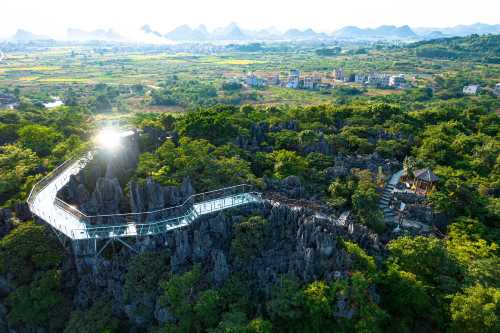Popular Trip Moments
Back from Hezhou: Some Honest Truths | Meihaolizhi Hotel (Fuchuan Phoenix Mountain) - A Dreamy Experience | Yunnan's Beauty, Mile's Charm: Dongfengyun - A Stunning Surprise | Best Spots for Couples + Comprehensive Guide | Discover the unique charm of Bucheon, South Korea. | A Relaxing Weekend Getaway from Guangzhou: The Perfect 3-Day, 2-Night Hezhou Itinerary | This isn't some far-off land!! It's Keda Blue Lake in Guangxi. | Hezhou–Guilin: A Relaxing Tour for Seniors | Explore Xiushui Zhuangyuan Village in Fuchuan, Guangxi, where ancient and modern beauty coexist | The flames have traveled through 400 years. I celebrate the New Year in the Yao Village in Guangxi | Xiushui Zhuangyuan Village began in the first year of Tang Kai's reign|I'm really afraid it will become popular in 2025... | Ancient Villages in Guangxi | Weekend Getaway with Friends | Bucheon Old Town | Ciyun Temple and Ruiguang Pagoda | This little treasure town is hidden at the border of Guangxi and Hunan. I will come again next time. | Huma Ridge Ancient Village, Fuchuan, Guangxi | Daliantang Ancient Village, Fuchuan, Guangxi. | General's Mansion, Xiushan Village, Fuchuan, Guangxi | Yang Ancestral Hall, Xiaogangtou Village, Fuchuan, Guangxi | Liujiawan Ancient Village, Fuchuan, Guangxi | Yang Ancestral Hall, Liujiawan Village, Fuchuan, Guangxi. | Dingshan Ancient Village, Fuchuan, Guangxi | Jigong Ancestral Hall, Shenpo Village, Fuchuan, Guangxi. | Shenpo Ancient Village, Fuchuan, Guangxi | Jiang Family Ancestral Hall, Shenpo Village, Fuchuan, Guangxi. | Hemu Ancient Village, Fuchuan, Guangxi | Gaoqiao Ancient Village, Fuchuan, Guangxi | Huilan Wind and Rain Bridge, Youmu Township, Fuchuan, Guangxi. | Qinglong Wind and Rain Bridge, Maojia Village, Fuchuan, Guangxi | Machu Dudu Temple in Fuxi Village, Fuchuan, Guangxi.
Recommended Attractions at Popular Destinations
Bangkok attraction near me | Manila attraction near me | Tokyo attraction near me | Taipei attraction near me | Hong Kong attraction near me | Seoul attraction near me | Kuala Lumpur attraction near me | Los Angeles attraction near me | Shanghai attraction near me | New York attraction near me | Shenzhen attraction near me | Osaka attraction near me | Singapore attraction near me | London attraction near me | Guangzhou attraction near me | San Francisco attraction near me | Beijing attraction near me | Macau attraction near me | Bali attraction near me | Jakarta attraction near me | Paris attraction near me | Ho Chi Minh City attraction near me | Istanbul attraction near me | Phuket attraction near me | Chicago attraction near me | Seattle attraction near me | Toronto attraction near me | Orlando attraction near me | Cebu attraction near me | Chiang Mai attraction near me
Popular Restaurants in Fuchuan
百味记小郡肝砂锅串串香(富川店) | 顺发水库鱼饭店(富川店) | 湘满堂饭店(汇龙店) | 拾光蛋糕坊 | YAO FEI | 四云奶盖贡茶 | 本位咖啡(富川店) | Meiweiji (fuchuan) | 聚豪阁水库鱼酒楼(富川店) | 正新鸡排(展兴二店) | YAO GU PU ZI | GUO GUO WANG TE SE TIE GUO FAN | 一品泉蒸饭馆(富川店) | 富川富阳鸿鑫饭店 | 李记风味小吃 | 好久不见 | 蒋记桂林米粉螺蛳粉 | 百香味火焰醉鹅(富川店) | Piaoxiangniuchangsuan | 蜜雪冰城(富川建设路店) | 繆斯酒吧 | 超鲜爽酸菜鱼粉(新建路店) | 小渝头火锅(富川店) | 心姐.一盏芳华 | 岔山特色油茶店 | 必胜基(富川店) | 披萨哥(富川店) | 功夫煲仔饭 | 芙蓉基FNC(富川店) | 刘师傅快餐
Popular Ranked Lists
Popular Premium Hotels in Pipa | Top 10 Local Restaurants in Kaifeng | Popular Premium Hotels in Thap Put | Top 10 Local Restaurants in Dongtai | Popular Premium Hotels in Brentwood Bay | Popular Premium Hotels in Midland | Top 5 Local Restaurants in Fusong | Top 3 Best Things to Do in Wenchuan | Top 6 Local Restaurants in Xianning | Popular Local Restaurants in Benxi County | Popular Luxury Hotels Near Goslar | Top 10 Local Restaurants in Xiangtan | Popular Best Things to Do in Ebian | Popular Best Things to Do in Haining | Popular Best Things to Do in Miyi | Top 4 Best Things to Do in Zhaotong | Top 9 Local Restaurants in Hengshui | Popular Premium Hotels in Durango | Popular Luxury Hotels Near Fell Lapland | Top 8 Best Things to Do in Baishan | Top 10 Local Restaurants in Fuding | Popular Best Things to Do in Guiping | Popular Best Things to Do in Qianwei County | Popular Local Restaurants in Huanggang | Popular Best Things to Do in Yangquan | Top 3 Best Things to Do in Xuchang | Popular Best Things to Do in Huaying | Top 3 Best Things to Do in Yuyao | Popular Luxury Hotels Near Maggona | Top 3 Best Things to Do in Chuxiong Prefecture
Payment Methods
Our Partners
Copyright © 2025 Trip.com Travel Singapore Pte. Ltd. All rights reserved
Site Operator: Trip.com Travel Singapore Pte. Ltd.
Site Operator: Trip.com Travel Singapore Pte. Ltd.








































